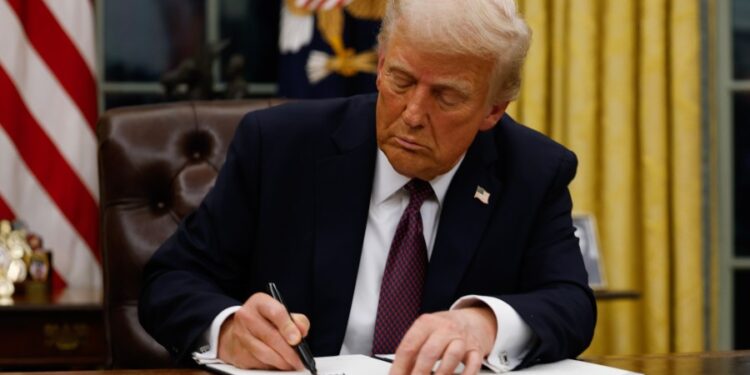
(NewsNation) — President Donald Trump is following through on his campaign promise to impose tariffs on America’s top trading partners — a decision that could come at a high cost to U.S. consumers.
Trump said Friday he would place a 25% tariff on imports from Canada and Mexico, as well as a 10% additional tariff on all imports from China. Energy resources from Canada will have a lower, 10% tariff.
The president wrote on Truth Social that the tariffs are meant to end “the decades long RIPOFF OF AMERICA” with regard to “TRADE, CRIME, AND POISONOUS DRUGS.”
The tariffs against Mexico have since been paused after Trump said he struck a deal with President Claudia Sheinbaum to supply 10,000 Mexican soldiers to the U.S.-Mexico border.
Nevertheless, Trump has acknowledged American consumers could bear some of the cost from the tariffs.
“We may have short-term, a little pain, and people understand that,” Trump told reporters on Sunday.
Here’s what to know about tariffs and how they could impact your wallet:
What are tariffs, and how do they work?
Tariffs are taxes on goods imported from other countries. They are typically charged as a percentage of the price a buyer pays a foreign seller.
So, a 25% tariff on a $4 good shipped from Canada or Mexico would face an additional $1 charge.
When companies import goods from abroad, they pay the tariffs to the U.S. government. However, economists warn those costs eventually get passed on to American consumers through higher prices.
Who pays for tariffs?
Companies — importers — pay tariffs on goods from abroad, and the money goes to the U.S. Treasury. If that sounds counterproductive, many economists argue that it is.
When companies face higher costs, consumers usually end up footing the bill.
For example, Trump imposed a tariff on imports of washing machines in 2018. Researchers estimate the price of washing machines increased by around 12%, about $86 per unit.
The Budget Lab at Yale University estimates Trump’s tariffs would cost the average American household $1,000 to $1,200 in annual purchasing power.
Even Trump has acknowledged Americans could feel “some pain” from the emerging trade war.
“WILL THERE BE SOME PAIN? YES, MAYBE (AND MAYBE NOT!),” Trump wrote on Truth Social. “WE WILL MAKE AMERICA GREAT AGAIN, AND IT WILL ALL BE WORTH THE PRICE THAT MUST BE PAID.”
While companies pay tariffs, they can indeed hurt foreign countries by making their products pricier and harder to sell abroad. Foreign companies could cut prices to offset the tariffs to maintain their market share in the U.S.
Why does Trump want tariffs?
Trump argues tariffs are a way for the U.S. to strike back against foreign countries he sees as ripping off America in terms of “TRADE, CRIME AND POISONOUS DRUGS.”
The president defended his tariffs on Canada in a social media post on Sunday: “We pay hundreds of Billions of Dollars to SUBSIDIZE Canada. Why? There is no reason. We don’t need anything they have. We have unlimited Energy, should make our own Cars, and have more Lumber than we can ever use. Without this massive subsidy, Canada ceases to exist as a viable Country. Harsh but true!”
Trump went on to say Canada should become our “Cherished 51st State.”
Canada is the largest source of U.S. energy imports, and, last year, 60% of U.S. crude oil imports came from America’s northern neighbor, according to the U.S. Energy Information Administration.
Previously, Trump said the tariffs against Canada and Mexico would remain until the countries crack down on the flow of drugs and “illegal aliens” coming into the U.S.
He said the additional tariff on China will stay until the country stops drugs, particularly fentanyl, from coming to the U.S.
What impact do tariffs have on the economy?
The effects of tariffs have long been debated, but economists on both sides of the aisle generally agree the costs tend to outweigh the benefits.
Americans could see higher prices on a range of goods the U.S. imports from its top three trading partners, including vehicles, fruits and vegetables, smartphones, toys, laptops and even fuel at the pump.
Tariffs can also lead to retaliation, with foreign countries responding by slapping their own taxes on goods from the U.S. After Trump’s announcement, Canada immediately ordered retaliatory tariffs on American goods.
Those who support tariffs often argue they prevent American businesses from offshoring jobs, but it’s not that simple.
Workers who produce the specific goods covered by tariffs often benefit, but tariffs can also hurt workers in other industries that rely on those imports.
In other words, a government tariff may be trading jobs in one industry at the expense of jobs in another.
A 2024 paper by a group of top economists looked at Trump’s 2018 tariffs and found that “import tariffs on foreign goods neither raised nor lowered U.S. employment in newly-protected sectors.” However, retaliatory tariffs had “clear negative impacts,” primarily in agriculture.
The Associated Press contributed to this report.







